Adobe Audition 7 was released in June 2014 with the name Adobe Audition CC 2014. New with this release came support for Dolby Digital and Dolby Digital Plus formats, custom channel labels, a new UI skin, High DPI support, enhanced clip and track colors. To get started, insert DeBreath onto your vocal track. When you play audio through the plug-in, DeBreath will automatically begin looking for breaths. Next, you should evaluate the detection quality, to see if DeBreath is making the choices you like. Solo the vocal track in your workstation, then use the Monitor switch to choose between Voice path.
Once upon a time, I used to be big into customization of the computer kind. Custom wallpapers, fonts, bitchin’ red LEDs on my tower…But those days are mostly gone. Except for the bitchin’ red LEDs. Because they’re still bitchin’. Anyway nowadays, I tend toward as vanilla a setup as possible. It’s just less work frankly. And that extends to my audio software. Generally speaking, I’m not huge into tweaking my sound, so I prefer not to use plugins. However, the one thing that I haven’t quite mastered technique-wise, is my diaphragmatic breathing, so I splurged on the DeBreath plugin from Waves Audio. I’ve been using it for probably four months or so, and I do actually find it really useful.
Here’s how it works: it scans through your audio and finds “breaths,” and reduces them by a specified amount. You can either dampen them, eliminate them completely, or eliminate them and replace them with the plugin’s room tone. Which option you choose will depend on your setup and how you perform. I personally use the default thresholds and dampen breaths by 10dB. Most of what I do is conversational, so I want to hear breaths, but taking 10dB off just helps them fade into the background. In fact, I run those settings on Use Your Voice.


If it sounds like something you might be interested in, here are some important things to note:
First, the DeBreath plugin is often on sale, so definitely DON’T pay $99 for it. I got it for $39. And yes, that sounds like a lot, but before I bought it, I was spending hours toning down unruly breaths by hand, so it was effectively paid for in my first project.
Second, DeBreath can be used with a wide variety of audio software, but it’s still probably worth checking the specs that yours is supported, before you buy. Just for a start, it definitely works with Adobe Audition, Pro Tools, Cubase, Ableton Live, and Garageband, as well as a whole bunch of others. Audacity doesn’t appear to be officially supported, but some users have reported that it does work just fine.
Next, you may need to train your breathing. DeBreath works best when you take short breaths rather than long drawn out ones, because of the attack and release of the process. I try to take short breaths just before the start of a sentence. But be wary that you don’t breathe in too loudly, or the plugin will mistake it for an intentional sound.
And finally, prepare to spend time testing it out in your normal conditions, before you need it. That way you can be sure you’ve got your levels set and there’s no weird artifacts, before you publish.
Hopefully, you find this little rundown useful…and of course, if you decided to try it for yourself (or if you already use it!) please drop me a line to let me know how you got on. The address for that is info@alisonpitt.com.
Debreath Adobe Audition 2020
With speaking comes breathing (duh), and sometimes a panelist might be drawing air in very loudly, or your vocal leveling tools might bring the breaths up, causing an uncomfortable experience for listeners. Here are the best ways to reduce loud breaths in a podcast, so your listeners can stay focused on the dialogue.
Adobe Audition Debreath
I’m a big fan of iZotope’s suite of filters, but their DeBreath module has been a disappointment. It doesn’t work as seamlessly as you’d expect (For example, it will sometimes think words are breaths), so I decided to look elsewhere for a tool that would reduce the loudness of breaths in the podcasts I edit.

The one tool I’ve found that really does a great job is Waves’ DeBreath Vocal Plugin. This tool accurately identifies breaths within dialogue and reduces them to your chosen level. They even added a ‘room tone’ setting that will apply some very subtle background noise. This way, it doesn’t sound like the audio channel has gone completely silent when someone is taking a breath.
DeBreath Plugin in Action:
I’ve been using this tool to reduce the loudness breaths but not completely remove them, as obviously it’s natural for someone to be taking breaths in between words or sentences. This plugin works much better than iZotope’s and has been pretty fool-proof in my experience, however, I’d recommend running this filter before editing, so that you can catch occasional mistakes it may’ve made.

My one complaint about this plugin is that it only supports mono tracks. I hope that one day they add support for stereo.
The only other good solution to this problem is simply reducing the loudness of the breaths manually, but this is a time-intensive task. The Waves plugin works with Adobe Audition and other DAWs, and at the time of this posting, is on sale for $25 (a 75% discount).
Debreath Adobe Audition Free
While I’m on the subject of Waves: I also really love their Noise Suppression plugin for removing background noise. This plug-in has a single slider for maximum ease of use, and can be much more effective than Adobe Audition’s. Just be careful about how much de-noising you apply!
